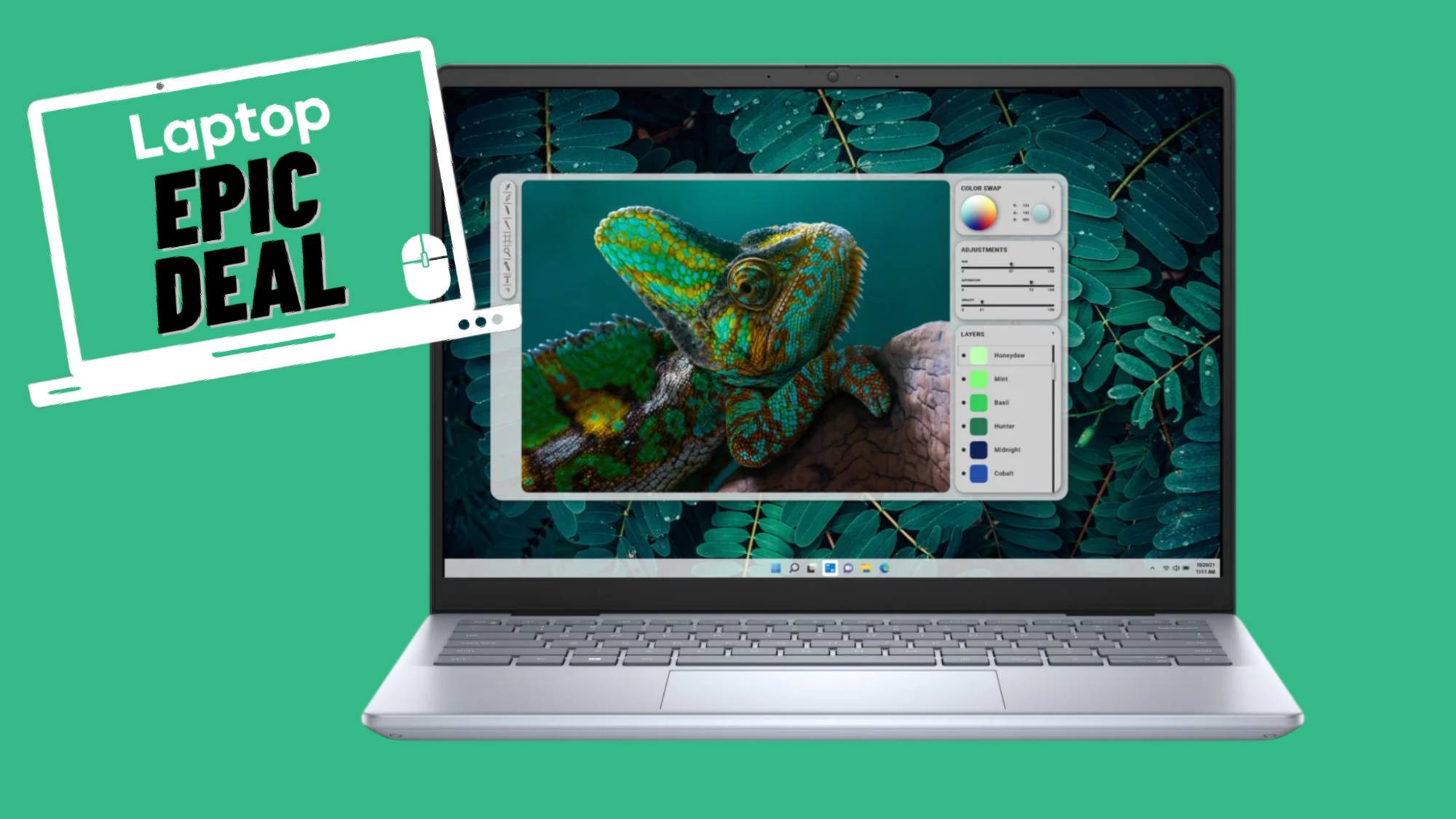Samsung Galaxy Gear Smartwatch Hands-on: Voice Calls, Camera, 70 Apps
Samsung has fired the first salvo in the smartwatch wars with the Galaxy Gear, announced at IFA 2013 here in Berlin. The smartwatch, which connects to Samsung's other newly announced devices, the Galaxy Note 3 and Galaxy Note 10.1, features a 1.63-inch 320 x 320 Super AMOLED touch screen and runs a modified version of Google's Android operating system. This device not only lets you make calls from your wrist, it has a built-in camera and will offer access to 70 or more apps at launch.
We spent some hands-on time with Samsung's new high-tech timepiece to bring you our first impressions. The feature set looks good, but would we wear one?
MORE: Samsung Galaxy Gear vs the Competition: Specs Compared
Samsung baked a 1.9-megapixel camera into the Gear's strap, and a speaker and noise canceling microphone into the buckle that allow you to make phone calls directly from the watch. Fashionistas will also be happy to hear that the Gear will be available in six colors at launch including Jet Black, Oatmeal Beige, Rose Gold, Wild Orange, Mocha Grey and Lime Green. And at 2.6 ounces and 2.2 x 1.4 x 0.44 inches, we felt perfectly comfortable with the Gear wrapped around our wrists.
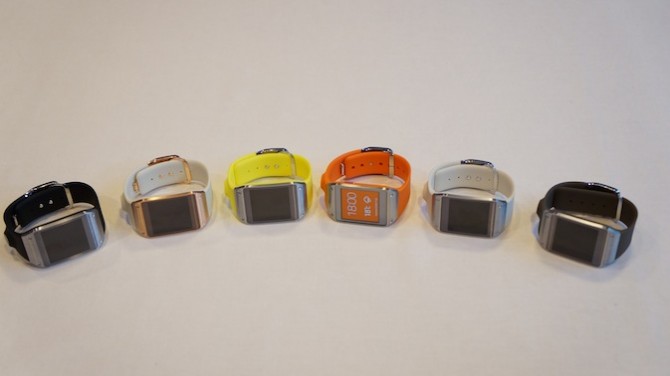
The Gear's main screen is a standard analog clock, but you can switch it out for one of 10 preloaded options via the Gear Manager companion app, which is installed on whatever device you choose to pair with the Gear. You can also download additional watch faces via the Samsung Apps store.
To navigate through the smartwatch's various menus, you swipe across the screen in different directions. Swiping down from the top of the screen when on the clock face, opens the camera, or Memographer app.
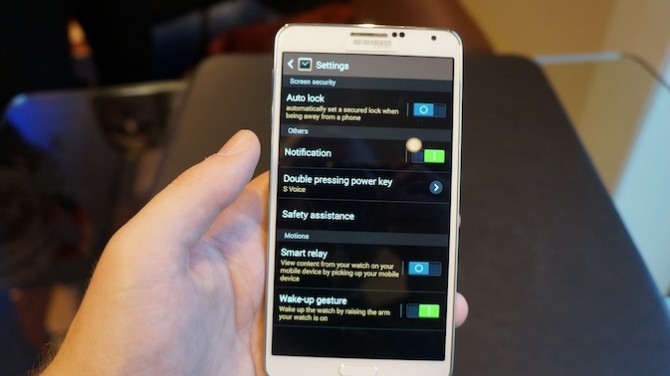
Swiping up from the bottom of the home screen opens the dialer app. From here you can dial phone numbers and place calls using the Gear connected to your Galaxy Note 3. (Other supported devices will come later.) Swiping from left to right and vice versa lets you navigate between the Gear's Settings menu, apps drawer and up to 10 customizable apps.
Stay in the know with Laptop Mag
Get our in-depth reviews, helpful tips, great deals, and the biggest news stories delivered to your inbox.
To set which apps appear on the smartwatch, you must first select them in the Gear Manager app on your paired device. To back out of apps, you can swipe down from the top of the screen, or press the Home button on the right side of the watch. Overall, we found navigating around the Gear to be intuitive. The touch screen was also accurate and quick to respond.
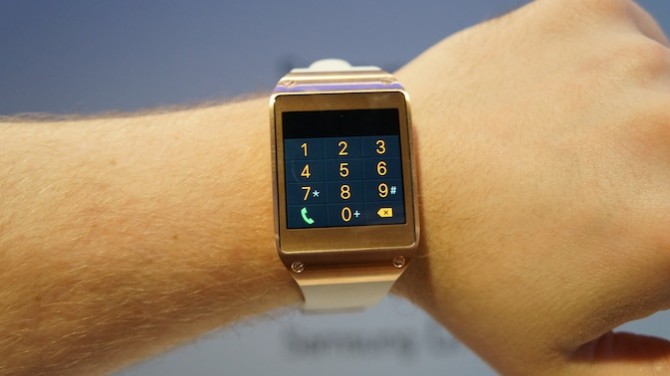
The Galaxy Gear's Memographer, or camera app, uses the 1.9-megapixel camera mounted on the watch's wrist strap to capture up to 50 photos and 10-second video clips shot at 720p resolution. Samsung says the camera isn't meant to supplant your smartphone, but rather to snap photos of those moments when you can't wait for you to pull out your handset.
To capture an image, you line up your subject and tap the Gear's display. Pressing the video camera icon in the top left corner of the screen switches the app oto video mode. Each time you close the camera app, by swiping down from the top of the screen, any images and video you shot will automatically be synced with your paired device.
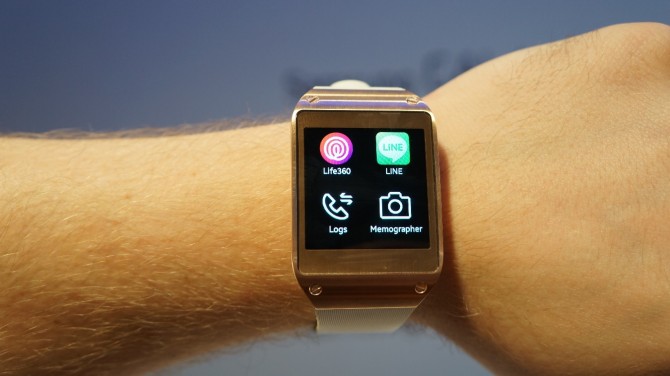
We were happy to see that the Galaxy Gear's camera includes a simulated shutter sound, which should keep users from surreptitiously taking photos of anyone nearby. However, while the Galaxy Gear's camera worked well during our hands-on, we couldn't help but feel as though the watch would be better off without it, due to the lens' rather large size compared to the rest of the device.
To make receiving notifications on your Gear as intuitive as possible, Samsung has developed a Smart Relay feature. The function works by providing you with a notification for any supported app stored on the smartwatch. After the Gear receives the notification, a similar notification will automatically appear on your paired device the next time you pick it up and you can view the content at full screen.
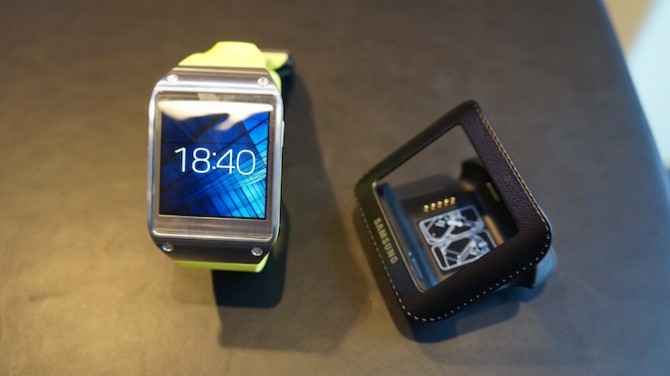
In order to save battery life, Samsung equipped the Gear with a sleep mode that puts the smartwatch's display to sleep after a set period of inactivity. Thankfully, the company also included an optional wake-up gesture that automatically powers on the watch's display when you lift your arm.
MORE: Samsung Galaxy Note 3 Hands-On
Other features of the Galaxy Gear include a built-in sensors to keep track of steps taken, calories burned and distance covered, similar to a pedometer. S Voice lets users draft messages, check the weather, set alarms and more with their voice, while Find My Device will help you find your lost Galaxy phone or tablet by making it beep, light up and vibrate. Last but not least, you can control your music from your wrist.
So what about apps? Samsung says there will be more than 70 options at launch, which you'll be able to download from Samsung's own app store. Some examples include Evernote for capturing images and keeping tabs on reminders, Glympse for location sharing, MyFitness Pal for tracking your nutrition and exercise and TripIt for organizing your travel plans. Other apps include eBay, Path and Pocket.
Overall, the Galaxy Gear looks like a compelling entry in the emerging smartwatch category. The interface is intuitive, the design is attractive, and it offers just enough functionality without feeling overwhelming. We don't see ourselves speaking into our wrists much for calls, but it's nice to know that the option is there, and we do like the idea of using S Voice on the go. While the Pebble has a more streamlined design and more apps available through third parties, the Galaxy Gear has it beat in terms of features and a built-in app store with bigger-name developers already on board. Stay tuned for our full review.

